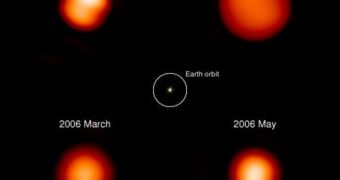Since modern Science and astronomy took off, in the last few hundred years, experts have made numerous discoveries pertaining to the nature of the Earth, the Sun and the Moon. One of these discoveries was the fact that the Sun was a yellow dwarf that had been generated some 4.57 billion years ago. As such, in about five billion years, it will reach the end of its burning cycle, and will turn into a red dwarf. While this was known to be the natural course of its development, scientists gain an even deeper understanding of the processes at work by analyzing a nearby, almost identical star.
The celestial object, a Mira-type star known as Chi Cygni, lies about 550 light-years away, in the constellation Cygnus. It features some of the most dramatic brightness variations known, oscillating from the fifth to the 13th magnitude over a period of 407 days. The star is a red giant, but holds great interest for astronomers because it was once just like our Sun. Chi Cygni is, however, a lot older, and it currently approaches the end of its burning cycle, when all its hydrogen fuel will be depleted, and it will become unable to sustain nuclear fusion.
“This work opens a window onto the fate of our Sun five billion years from now, when it will near the end of its life,” Observatoire de Paris expert Sylvestre Lacour, who has also been the lead author of the investigation, explains. He says that, over the course of its oscillations, the red giant goes from having a diameter of 300 million miles to one of roughly 480 million miles. As it expands, the star cools down and sheds some of its atmosphere's outer layers, which can no longer remain attached to the core. Seen from far away, the structure looks like a giant heart, beating once ever couple of years or so.
“We have essentially created an animation of a pulsating star using real images. Our observations show that the pulsation is not only radial, but comes with inhomogeneities, like the giant hotspot that appeared at minimum radius,” Lacour says. A scientific paper detailing the amazing findings appears in the December 10 issue of The Astrophysical Journal. For the difficult observations, the team used the Infrared Optical Telescope Array (IOTA), which is operated by the Smithsonian Astrophysical Observatory. The facility is located at the Whipple Observatory, on Arizona's Mount Hopkins.
“IOTA offered unique capabilities. It allowed us to see details in the images which are about 15 times smaller than can be resolved in images from the Hubble Space Telescope,” Harvard-Smithsonian Center for Astrophysics (CfA) astronomer Marc Lacasse, who is also a coauthor of the journal entry, says. In the future, he adds, interferometry will become the norm for astronomical observations, and structures such as stellar surfaces, black hole accretion disks, and planet-forming regions surrounding newborn stars will reveal their true nature.

 14 DAY TRIAL //
14 DAY TRIAL //